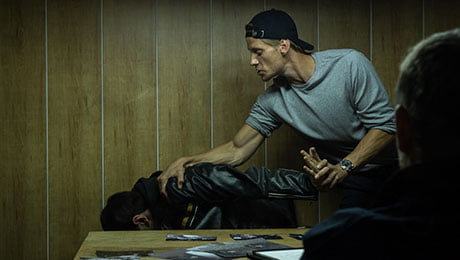Sony Pictures Television Networks – CEE
Posted By Gün Akyuz On 17-07-2018 @ 5:56 pm In Alerts | Comments Disabled
SCHEDULE WATCH PROFILE: Sony Pictures Television Networks (SPTN) has been revving up its local production ambitions across Central and Eastern Europe, with room for some interesting partnerships. Gün Akyuz reports.

John Rossiter
Overview
SPTN is taking a “very aggressive” local production stance across its pay channel brands in Central and Eastern Europe (CEE), according to John Rossiter, freshly promoted from general manager for Central Europe to exec VP of distribution and networks for CEE, the Middle East and Africa.
“We’ve ramped up our production in the region in two years to 300 hours and we intend to double that. We see ourselves as a production powerhouse,” the exec told C21 ahead of his promotion, which was part of Sony Pictures’ recent restructuring of its international television operations [1].
Scripted is a key growth area within this. Rossiter believes the recent sale of SPTN channel AXN’s Polish drama Ultraviolet to Netflix is representative of the sort of deal that will allow Sony’s CEE production hub to act not only as a local supplier within the region, but also as an international one. “It helps the local production ecosystem and ups our profile in how we reach the customer. It’s about how we build on that,” he says.
SPTN’s portfolio of channels includes Viasat3 and Viasat6 in Hungary, plus AXN, Sony Max, Sony Movie Channel, SVoD service AXN Now and digital services Viasat Play and AXN Player across the region. Having launched last October, Sony Movie Channel and Sony Max are the latest additions to the group’s regional portfolio.
Across all channels, SPTN attracted a 5.4% share of 18-49s in the first quarter of this year. “Over the past six months, we’ve really worked on positioning and communication, and productions have started to kick in,” says Rossiter. “We’re not the largest portfolio in the market but we’re very time-valuable from an advertiser perspective.”

Ide Süss!, the Hungarian version of the Bake Off format, launched in March
Current schedule, original production, entertainment, formats
Female-skewing Viasat3 saw significant activity this spring. In March, the channel successfully launched Ide Süss!, the Hungarian version of The Great British Bake Off.
Scheduled weekly at 20.00, the show pulled in a 3-4% share, with its most viewed episode achieving a 5.7% share of 18-49s. “In terms of the overall share for the day, if we can get an original production on, the overall share does better,” says Rossiter.
Over on male-skewing Viasat6, Sony has partnered with producers for local football-focused show Büntető, a dusted-down format that aired alongside the recently concluded Fifa World Cup.
The channel’s first local production under Sony ownership was Totalcar, a show similar to the BBC’s Top Gear. First launched in spring 2016, it has now run for four seasons.
“Once we got the positioning for Viasat3, which concentrates on 18-39s and is slightly female-skewing – and the same for men for Viasat6 – we could take more chances on a variety of things,” Rossiter notes.
One of Viasat3’s first local productions under Sony was quiz format Mindblowers, which was extended into a daily show last fall. “It has been an enormous success,” says the exec. On average, the show attracted a 4.3% share of 18-49s in its 20.00 weekday slot, with the most viewed episode achieving 7.7%. “We want to go more daily because of the impact on the schedule,” explains Rossiter.

The local version of Sony format Mindblowers airs on Viasat3
Another success is The Real Housewives of Hungary, Viasat3’s version of the Real Housewives format, which launched last fall. Rossiter says season two, which followed swiftly on the heels of Bake Off, attracted around two million streams per episode and an average share of 3.5% of core female viewers (18-39s) in its 21.00 slot on Mondays. “Once you get your production and your positioning right, it gets easier,” he comments.
However, not all original productions have worked, with Flúgos Futam (Wacky Run) proving a disappointment on Viasat3 in 2016, for example. “We learn from that and we’re honing ourselves,” Rossiter notes.
A new round of local shows has been lined up for the channel this autumn, including a daily scripted romantic comedy in a run of 60 episodes. The programme has been adapted from Argentine comedy Ciega a Citas, which was acquired from Dori Media. Sony Productions Hungary is producing, with the show earmarked for access primetime, where the channel usually schedules acquired romcoms.
Another newcomer this fall will be daily stripped quizshow KérdezŐ, an in-house Sony format and production hosted by Gábor Gundel Takács, one of Hungary’s most popular quizmasters.

AXN drama Ultraviolet has been picked up by Netflix
Drama
Over in Poland, Sony has been notching up a few local scripted successes with shows such as Ultraviolet, which was later picked up by Netflix. The show has been pulling in almost four million viewers on AXN so far. Rewir (District), a daily scripted reality series that launched on AXN Poland in April 2017, has also been a hit.
Arriving this October is the local crime mystery Znaki (Signs). Rossiter says the procedural offers a different approach to storytelling, with an interesting new twist.
Alongside series such as Ultraviolet and Signs, Rossiter points to a handful of other projects on which the group is now working in partnership with undisclosed platform operators and streamers. “We’ve talked about partnering locally at a European level,” say the exec. “Owning our own programming and exploiting it in multiple markets is good for us. Getting a Polish show [like Ultraviolet] to screen in Venezuela is a huge thing, and the world is going global. It’s just the quality bar that needs to be met, and that’s not so easy.”
Digital, multi-platform
Highlighting Netflix’s rapid growth and its ability to deliver quality programming to customers, Rossiter says there are lessons traditional media companies can learn from streamers.
“A number of these players have thought very global, they’ve thought very big and they’ve thought very fast. They’ve concentrated on bringing great programming to customers; they’ve grown and been successful,” says the exec.
“Not every show on Netflix or on our channels is a huge runaway success. But there’s tremendous opportunity in thinking bigger, more globally, being faster and more flexible. That’s the key, and that’s one thing more traditional media companies need to be better at. How do we quickly serve the consumer? How do we get to where we want to be? There’s a lot of talk about this, but these guys are doing it.”

US shows like Absentia help attract viewers to AXN Now
SPTN’s own SVoD service, AXN Now, partnered by local platform operators, has around three million subscribers in 13 countries across its CEE footprint, including Poland, Hungary, the Czech Republic, Slovakia, Romania, Bulgaria and Serbia. Rossiter says the streamer has grown significantly and is doing well for the group, but it still needs to grow further. “We’ve bought a lot of unique content for AXN Now, and over half of it is unique to the service and not catch-up. Not all programming is equal, and when you’re an SVoD service you want more bingeable shows that may not rate in linear.”
As part of the global AXN family, the brand also benefits from Sony’s US shows like Absentia and Carter, which have helped drive viewing on the service, says Rossiter. AXN Now also has a range of different packages with licensors, and a priority for the platform is bingeable, box-set dramas – something that will have a greater impact, according to Rossiter.
Also paramount is the need “to produce to feed all our different outlets,” the exec continues. While no unified total measurement across platforms exists at present, Rossiter notes: “We’re seeing that if we combine a digital sale with a TV sale, we’re selling total reach and starting to see growth.”
The Real Housewives of Hungary generated 3.3 million streams online in its first season and another two million in its second. “That’s pretty substantial traffic for a country of 10 million,” says Rossiter. “With Ultraviolet, we did some catch-up stunts. We’ve obviously got to be very careful with something that’s on the SVoD service, but we’ve seen some good figures.”
SPTN is also more than happy with Bake Off Hungary’s 3-4% terrestrial share, Rossiter says, adding: “When you look at the demos, however, what’s different between linear and online is the audience age.”

The Real Housewives of Hungary has registered impressive viewing figures online
On television, the show attracted an average audience age of between 35 and 45, while online it was predominantly between 18 and 35. “The same show, watched delayed online, got an audience with different viewing habits in terms of the platforms where they watch the show and the time when they consume it,” Rossiter explains. “If you’re there to entertain people and you’re doing it right, you can get an audience. The trick is how quickly you can drive that audience – how to monetise and not cannibalise. I see amazing opportunity coming.”
With SPTN now having tested a range of shows within its confines, from quizzes, reality shows, docuseries, scripted reality, crime dramas and now romcoms, Rossiter adds: “I would like to do more scripted, and as a business we want to do more scripted for the portfolio,” indicating that a couple of as-yet-undisclosed scripted coproductions are now in the pipeline. “We’re extremely flexible, we know what we want to do and scripted makes sense. We’re growing that, and having several partners will help you achieve those goals more quickly.”
Rossiter is also on the lookout for a range of new content and projects. “You have to be at the markets,” he says. “The biggest mistake you can make is saying you’ve seen it all. You really want to be hungry – there could be a format from Mexico or Venezuela that would be a wonderful thing to adapt. Israel has been a leader in terms of driving our tastes, experimenting with storytelling, and I think you’d want to look at that. We tend to look at a wide variety of genres we can experiment with, and there will always be a gameshow, reality show or drama we’re looking for.”
The exec concludes: “As a studio, Sony has its own DNA. It makes sitcoms, drama, action shows and movies, and we want to stick to that DNA as much as possible and be an outlet for it.”
Article printed from C21Media: https://www.c21media.net
URL to article: https://www.c21media.net/sony-pictures-television-networks-cee/
URLs in this post:
[1] restructuring of its international television operations: https://www.c21media.net/kaplan-out-in-sony-shake-up/
Click here to print.